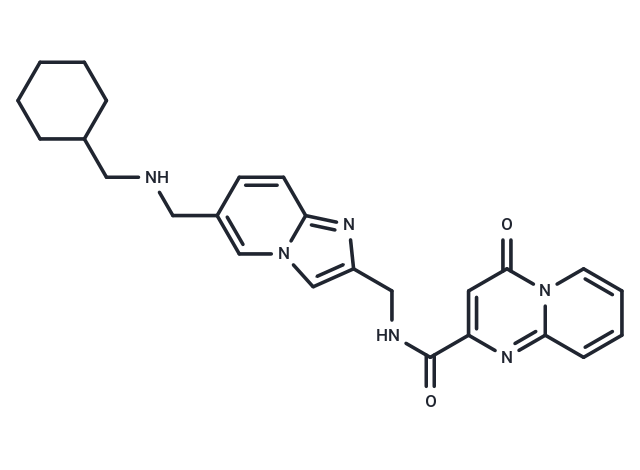Shopping Cart
Remove All Your shopping cart is currently empty
Your shopping cart is currently empty
STM2457 is an inhibitor of the RNA methyltransferase METTL3 (IC50=16.9 nM) with selective and oral activity.STM2457 can be used in acute myeloid leukemia (AML) studies.

| Pack Size | Price | USA Warehouse | Global Warehouse | Quantity |
|---|---|---|---|---|
| 1 mg | $101 | In Stock | In Stock | |
| 5 mg | $216 | In Stock | In Stock | |
| 10 mg | $349 | In Stock | In Stock | |
| 25 mg | $579 | In Stock | In Stock | |
| 50 mg | $828 | In Stock | In Stock | |
| 1 mL x 10 mM (in DMSO) | $237 | In Stock | In Stock |
| Description | STM2457 is an inhibitor of the RNA methyltransferase METTL3 (IC50=16.9 nM) with selective and oral activity.STM2457 can be used in acute myeloid leukemia (AML) studies. |
| Targets&IC50 | METT L3 cells:16.9 nM, AML cells:0.6-10.3 μM, MOLM-13 cells:8.699 μM |
| In vitro | METHODS: Eight human acute myeloid leukemia cells AML were treated with STM2457 (0-100 μM) for 72 h. Cell proliferation was detected using CellTiter 96 AQueous Non-Radioactive Cell Proliferation Assay. RESULTS: STM2457-treated AML cell lines showed a significant reduction in growth after treatment in a concentration-dependent manner, with IC50s ranging from 0.6-10.3 μM. [1] METHODS: Human lung cancer cells A549 and H1975 were treated with STM2457 (1-5 μM) for 3-6 days and apoptosis was detected using Flow Cytometry. RESULTS: STM2457 induced apoptosis in A549 and H1975 cells. [2] |
| In vivo | METHODS: To assay anti-tumor activity in vivo, STM2457 (50 mg/kg) was administered intraperitoneally to NSG mice bearing xenografts derived from human AML patients once daily for twelve to fourteen days. RESULTS: Daily treatment with STM2457 resulted in impaired implantation and AML amplification in vivo and significantly prolonged mouse lifespan. [1] METHODS: To investigate the role of METTL3 in the pathogenesis of systemic lupus erythematosus (SLE), STM2457 (30 mg/kg) was administered intraperitoneally to a cGVHD lupus mouse model once every three days for ten weeks. RESULTS: METTL3 inhibition increased antibody production and exacerbated the lupus-like phenotype in cGVHD mice.METTL3 inhibition is involved in the pathogenesis of SLE by participating in the imbalance between CD4+ T cell activation and effector T cell differentiation. [3] |
| Molecular Weight | 444.53 |
| Formula | C25H28N6O2 |
| Cas No. | 2499663-01-1 |
| Smiles | O=C(NCc1cn2cc(CNCC3CCCCC3)ccc2n1)c1cc(=O)n2ccccc2n1 |
| Relative Density. | 1.35 g/cm3 (Predicted) |
| Storage | Powder: -20°C for 3 years | In solvent: -80°C for 1 year | Shipping with blue ice/Shipping at ambient temperature. | |||||||||||||||||||||||||||||||||||
| Solubility Information | DMSO: 49.5 mg/mL (111.35 mM), Sonication and heating are recommended. | |||||||||||||||||||||||||||||||||||
| In Vivo Formulation | 10% DMSO+30% PEG300+5% Tween 80+55% ddH2O: 4.76 mg/mL (10.71 mM), Solution. 10% DMSO+40% PEG300+5% Tween 80+45% Saline: 2.22 mg/mL (4.99 mM), Solution. Please add the solvents sequentially, clarifying the solution as much as possible before adding the next one. Dissolve by heating and/or sonication if necessary. Working solution is recommended to be prepared and used immediately. The formulation provided above is for reference purposes only. In vivo formulations may vary and should be modified based on specific experimental conditions. | |||||||||||||||||||||||||||||||||||
Solution Preparation Table | ||||||||||||||||||||||||||||||||||||
DMSO
| ||||||||||||||||||||||||||||||||||||
| Size | Quantity | Unit Price | Amount | Operation |
|---|

Copyright © 2015-2025 TargetMol Chemicals Inc. All Rights Reserved.